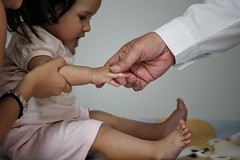______________________________________________________

It’s back-to-school season once again, which means it is also time to immunize . Vaccination protects children against serious and even deadly diseases like measles and pertussis.
Different vaccinations are recommended for different age groups, from birth to adulthood. The CDC provides a list of recommended vaccinations for infants and toddlers, kids and teenagers, and adults and seniors. People with certain health conditions, who travel overseas or who are pregnant may require other vaccines, so talk with your doctor.
Some parents have questions or concerns about the safety and effectiveness of vaccines. In addition to being required for school, vaccines have been proven safe and effective in dozens of scientific studies.
One vaccine many people are concerned about is the HPV vaccine. Click here to see an amazing graphic showing both the efficacy and safety of the HPV vaccine. Discuss any questions or concerns you may have with your child’s physician. If cost is a concern, there is a government program which can cover the cost of vaccinations .
Getting vaccinated is one of the simplest and most effective ways to protect your health and the health of your family.
______________________________________________________

After the long cold of winter, summer is finally here! But before you take advantage of the long beautiful days, you should do as the Australians do, and Slip on shirt, Slop on some sunscreen and Slap on a hat.
Sunlight contains UV radiation. Excessive exposure to UV radiation is a major cause of skin cancer. It also causes sunburn, wrinkles, cataracts, skin discoloration and other signs of aging. People with light-colored skin, hair and eyes are at the most risk, but anyone can get a sunburn. The UV index is a measurement of how much UV radiation is reaching the Earth’s surface; the higher the number, the greater the UV radiation.
The best way to avoid excessive exposure to UV radiation is to stay out of the sun, especially between 10 am and 4 pm, when UV radiation is strongest. If you do go outside, wear a hat, long sleeved shirt and pants, and sunglasses to protect your eyes. Apply sunscreen and to any exposed skin, and reapply every hour or so. Don’t forget your ears, lips and the top of your head. No sunscreen is totally waterproof, so reapply after being in water. To learn more about the effects of sunscreen and how to use it, check out this great, in-depth chart.
The FDA regulates sunscreen labels . These rules are designed to provide consumers with more comprehensive data about sunscreen.
Some people use tanning beds as an alternative to laying out in the sun, but the UV radiation from tanning beds is just as harmful as that from the sun. If you want to get a tan while avoiding the aging and cancerous effects of UV radiation, consider sunless tanning lotions or sprays.
Do regular skin self-exams to check for any of the early warning signs of cancer, like new or changing moles or skin lesions. Like most cancers, skin cancer is easiest to treat if caught early. Anyone can get skin cancer, even people with dark skin.
______________________________________________________

One in five people who have HIV are not aware that they have it. One in 3 people who are diagnosed with HIV are diagnosed too late to get the most effective treatment. You can protect your health and the health of your loved ones by getting tested for HIV.
Many people with HIV do not feel or look sick. The only way to be certain that you don’t have HIV is to get tested. Look here for testing sites near you, or text your ZIP code to KNOWIT (566948). Many organizations offer free or low-cost HIV and other STI screenings. There is no cure for HIV/AIDS, but with treatment, patients can live long and happy lives.
HIV (human immunodeficiency virus) is a virus which is transmitted through certain bodily fluids, like blood, through sexual contact or sharing needles. HIV cannot be transmitted through casual contact, like hugging, kissing or sharing eating utensils. A person may have HIV for many months or years before it progresses to AIDS (acquired immunodeficiency syndrome).
Anyone can get HIV, regardless of age, gender or sexual orientation. Check here to see if you are at risk, and what you can do.
The best way to avoid getting HIV is to avoid exposure to contaminated body fluids by using condoms or dental dams .
If you believe you have been exposed to HIV, you should immediately go to your local emergency room or urgent care clinic. There is a treatment, called post-exposure prophylaxis or PEP, which can reduce your risk of getting HIV. However, these medicines work best within 36 hours of exposure.
______________________________________________________
Spring is in the air, and now is the perfect time to get out and get active. Being physically active is one of the healthiest things you can do. Regular exercise reduces stress, helps you live longer, and reduces your risk of diabetes, high blood pressure, heart disease, cancer and other diseases.
Many people think that physical fitness has to involve the gym, lifting weights, and the dreaded treadmill. But the best exercise program is the one that you enjoy, whether it’s walking the dog, playing with your kids, dancing, or Frisbee. Check here for a list of activities that you may enjoy. Get your friends and family involved as well. Having an exercise buddy or group can help you stay motivated.
You can also increase your activity level by President’s Physical Fitness Challenge is a great resource for kids and adults.
Experts recommend 2 hours and 30 minutes of moderate physical activity or 1 hour and 15 minutes of vigorous activity each week. That sounds like a lot, especially if you aren’t currently active, but it translates to only 10 to 20 minutes of activity each day. The key is to start small and make physical activity a part of your daily routine. Once you’re in the habit of exercising, you can start to increase the amount of exercise you do each day. Find more information about getting started here.
If you have a health condition like heart condition or arthritis, don’t let it stop you from getting healthy. Talk with your doctor to work out an exercise plan that meets your needs. Even if you don’t have a health condition, you should still talk with your doctor before starting an exercise plan. In addition to making sure you are able to exercise, your doctor can give you advice on preventing injuries and setting long-term goals.
______________________________________________________

We frequently hear news reports about the benefits of drinking alcohol. Although there are some health benefits associated with drinking a moderate amount of alcohol, alcohol can also have many negative health effects. Stomach and esophageal cancer, liver disease, and sleep problems, along with other diseases, are linked to high alcohol consumption.
People who choose to drink should limit themselves to one (for women) or two (for men) drinks a day, and should avoid binge drinking , which is defined as 4 drinks in a sitting for women and 5 drinks for men.
If you answer "yes" to any of the following questions, you may have a problem with alcohol:
Do you drink alone when you feel angry or sad?
Does your drinking ever make you late for work?
Does your drinking worry your family?
Do you ever drink after telling yourself you won't?
Do you ever forget what you did while drinking?
Do you get headaches or have a hangover after drinking?
If you are worried about your alcohol intake, you can find strategies for cutting down or quitting here. There are many resources for those who may have a problem with alcohol. If you are worried that a friend or a family member may have a drinking problem, organizations like Alcoholics Anonymous and Al-Anon /Alateen also provide resources to help you help them.
You should also talk with your physician about ways to cut down on drinking. Women and adolescents are at especially high risk from overconsumption of alcohol. Because women generally weigh less, and have a different body composition than men, the same amount of alcohol can cause much more damage in women than men . Alcohol can increase the risk of breast cancer, especially among women already at risk. Women who may become pregnant must also be cautious. Drinking while pregnant can cause fetal alcohol syndrome, a 100% preventable disease.
Because teenagers’ brains are still developing, they are especially vulnerable to damage caused by alcohol consumption. Teenagers are also more likely to engage in binge drinking and risky behaviors, like casual sex or fighting, while drunk. Parents can make a difference by talking with their kids about the dangers of alcohol abuse.
______________________________________________________

Only about 55% of people at risk for colon cancer get screened. People over the age of 50 are that the greatest risk of developing colon cancer, so everyone over 50 should be screened. People with other risk factors, like smokers, people with a family history of cancer, and African-Americans should be tested for colon cancer earlier. This calculator can help you determine your risk.
You can reduce your risk of getting colon cancer by quitting smoking, maintaining a healthy weight and staying active. A diet low in red meat and high in fruits and vegetables can also help reduce your risk.
If you have a friend or family member who is over 50, you can help them by encouraging them to get tested for colon cancer. It can be an awkward conversation, but it may help save their life. Here are a few conversation starters .
______________________________________________________

If you have chest pain, shortness of breath, arm or back pain, sudden numbness or weakness, sudden confusion, trouble seeing or walking, or a sudden, severe headache call 911 immediately. There are many effective treatments for heart attack and stroke, but all work best if taken as quickly as possible. A false alarm is much better than a fatal incident.
You can prevent heart problems by making simple changes in your life. Regular exercise, a diet low in cholesterol and high in fruits and vegetables, controlling your blood sugar and quitting smoking helps lower your risk. Plus, good diet and exercise will reduce your risk for other health problems like cancer and diabetes. Talk to your doctor for other strategies that fit your lifestyle.
You can save a life. Take a CPR class through the American Heart Association or the Red Cross. People who receive CPR from bystanders are more than twice as likely to survive a heart attack. If you witness a heart attack, the most important thing is to call 911 immediately.
______________________________________________________

One in 33 babies in the United States is born with a birth defect. Many of these birth defects are easily prevented during pregnancy with proper nutrition and prenatal care. Be sure to speak with your doctor regularly when you are pregnant or planning on becoming pregnant . Every state has resources to help women pay for medical care during pregnancy. Click here to find information for your state.
The best time to prevent birth defects is before conception. Learn what you can do to optimize the health of your baby at all stages of your pregnancy. Pregnant women need to eat right, exercise regularly and avoid alcohol and tobacco products. Some medications are harmful to the developing fetus, so women who are pregnant or planning to become pregnant should also discuss their prescription and over-the-counter medications with their doctor.
One of the most important nutrients for pregnant women is folic acid. Folic acid (aka folate or vitamin B9) helps the fetus develop normally. Lack of folic acid can cause birth defects like spina bifida . Recent research suggests that folic acid supplementation also helps your baby get a head start in life. Children of women who took folic acid and iron supplements during pregnancy were smarter and had better motor skills than their peers.
Once your baby is born, be sure to have a newborn screening done. These tests check for certain diseases so that they can be treated before symptoms appear. These tests are relatively simple and painless for your baby.
______________________________________________________

December 1st is World AIDS Day. It is a day to fight the myths and misconceptions that surround HIV/AIDS, and to work towards a cure.
HIV (human immunodeficiency virus) is a virus which is transmitted through certain bodily fluids, like blood, through sexual contact or sharing needles. HIV cannot be transmitted through casual contact, like hugging, kissing or sharing eating utensils. A person may have HIV for many months or years before it progresses to AIDS (acquired immunodeficiency syndrome). Anyone can get HIV, regardless of age, gender or sexual orientation.
The best way to avoid getting HIV is to avoid exposure to contaminated body fluids by using latex gloves or condoms.
If you believe you have been exposed to HIV, you should immediately go to your local emergency room or urgent care clinic. There is a treatment, called post-exposure prophylaxis or PEP, which can reduce your risk of getting HIV. However, these medicines work best within 36 hours of exposure.
Many people with HIV do not feel or look sick. The only way to be certain that you don’t have HIV is to get tested. Look here for testing sites near you. Many organizations offer free or low-cost HIV and other STI screenings. There is no cure for HIV/AIDS, but with treatment, patients can live long and happy lives.
______________________________________________________

First, know your risk. People who are overweight, exercise infrequently, have high blood pressure and members of certain ethnic groups are at greater risk. Once you know your risk, you can reduce it by eating healthy and staying active. Check out these prevention strategies.
Uncontrolled diabetes increases your risk of stroke, heart attack, blindness and amputations. But, if you have been diagnosed with diabetes, you can still live an active, healthy lifestyle. Look for diabetic recipes ,monitor your blood glucose regularly, and stay informed about the latest treatments.
______________________________________________________

Breast cancer is the second most common cancer in women, after skin cancer. About 1 in 8 American women will battle the disease at some point in their life. The good news is that with early detection and advances in medical technology, breast cancer survivors are living longer and healthier lives than ever.
Early detection is key. The earlier breast cancer is detected, the easier it is to treat. Every woman should perform a breast self-exam once a month. Women over the age of 40, with a family history of breast cancer, or with other risk factors , should also have a mammogram. If you do not have health insurance, the CDC can help you find low-cost or free mammograms .
Men are also at risk.. About 2000 men are diagnosed with breast cancer each year. Just like in women, early detection is key to survival. Men should see their doctor if they notice any unusual lumps, dimples or discharge.
You can take action to reduce your risk of breast cancer. Alcohol intake, lack of physical activity and obesity are all linked to an increased risk of developing breast cancer. By exercising more and drinking less, you can make a positive impact on your health.
______________________________________________________

Sheila Maier, M.S. is a Grillo Health Information Center volunteer. Grillo Center Monthly Health Topics are licensed under a Creative Commons Attribution-NoDerivs 3.0 Unported License. Image license details can be found by clicking on the image.
More information about these and other health topics can be found at the National Health Observances website and Questions are the Answer.
